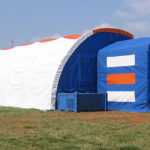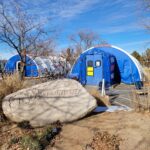The Importance of HVAC Systems for Alternate Care Facilities
To help treat COVID-19 patients, alternate care sites are being used across the nation. Alternative care facilities offer a quick way to provide urgent medical care to patients during hospital surges. However, it is important to still take proper safety measures to ensure this solution is more helpful than harmful. And that’s where the importance of heating, ventilation, air-conditioning (HVAC) systems for alternate care facilities come in.
That is, alternate care sites should have many of the same safety measures as permanent hospitals. This includes having the proper HVAC systems for alternate care facilities.
What Is an Alternate Care Site?
In short, an alternate care site is any structure that is converted or set up for temporary healthcare use. Essentially, they help governments, hospitals, and other healthcare agencies expand capacity. This way, they can provide care to a surge of patients.
Potential alternate care facilities may include any of the following:
- Pop-up tents, canopies, or inflatable medical tents
- Hospital containers or medical trailers
- Repurposed convention centers or college dorms
- Reopening abandoned or closed hospitals
- Mobile medical shelters or field hospitals
[Related: Key Elements of Pandemic-Ready Healthcare Facilities]
What Are The Advantages of Medical Shelters for Alternate Care Sites?
As we just mentioned, many different structures can serve as alternate care facilities. However, there are several advantages of using medical shelters in particular. Here are just a few reasons why.
Designed for Durability
First, medical shelters are designed for durability. Unlike pop-up tents, canopies, and inflatable medical tents, high-quality medical shelters are the most durable option among instant structures.
While many pop-up tents, canopies, and inflatable medical tents offer speedy times, they are not engineered structures. This means they are not designed to do any of the following:
- Withstand heavy snow loads.
- Survive high wind speeds.
- Resist water, mold, and mildew.
As a result, nonengineered pop-up structures put patients, staff, and equipment at risk. At any moment, the structure is at risk of collapsing or blowing away. On the other hand, an engineered medical shelter provides safety, security, and peace of mind during inclement weather or year-round use.
Fast to Build, Move, and Reuse
Of course, medical shelters are not the only durable option for medical care facilities. For instance, healthcare agencies may choose to reopen a previously closed hospital for alternative care. However, this has a major disadvantage. It can take weeks or even months to set up.
As we mentioned at the start, alternative care sites are supposed to be a fast solution. In other words, they should be available for emergency use as quickly as possible. Speed is not feasible when reopening a closed or abandoned hospital. After all, the following tasks need to be completed before patients can be seen or admitted:
- Bring lighting and electrical systems back online.
- Update HVAC systems to meet current standards of safety.
- Remove any dust, mold, and mildew and sanitize the space.
These tasks can take lots of effort and money to achieve — especially if the building sat vacant for many years.
Alternatively, healthcare agencies may opt for using hospital containers. These are durable structures that don’t take nearly as long as a hospital reopening.
However, they still don’t provide the setup speed that an alternative care site needs. They are bulky and hard to move. Thus, they require heavy machinery to lift and set up. As a result, hospital containers can take hours to install, and patients are left waiting to receive the urgent care they need.
In contrast to these, medical shelters provide a major advantage in speed. Here are just a few examples of how:
- They are easy to transport to the location when and where needed™.
- There are medical shelters that can be built in less than 10 minutes!
- Disassembly, relocation, and expansion are fast and easy.
Speed Without Sacrificing Safety
Importantly, medical shelters and mobile field hospitals like those from BLU-MED Response Systems® provide speedy urgent care without sacrificing safety. This is essential for any alternative care facility. And it’s important not to ignore safety, even when repurposing convenient buildings like large convention centers.
Convention centers make for fast alternative care facilities because they have:
- Working electrical systems and lighting
- Clean dust-free rooms
- Large interior space to accommodate social distancing
- HVAC systems that meet current building codes
However, these HVAC systems are not medical grade and are often not designed to remove airborne diseases. This has the potential to compromise the safety of staff and patients.
In contrast, medical shelters have the necessary HVAC systems for alternate care facilities and are equipped with HEPA and UV germicidal filtration.
[Related: How to Use Hospital Surge Facilities After the Pandemic]
How HVAC Systems Benefit Alternate Care Sites?
The proper HVAC systems for alternate care facilities make all the difference in safety and comfort. They help do the following:
- Filter airborne contaminants and particulates.
- Get rid of bacteria and other microorganisms that spread infection.
- Remove and dissipate unpleasant odors.
- Make breathing easier for patients with compromised respiratory systems.
- Maintain a comfortable temperature, even in harsh weather.
Portable Environmental Control Units From BLU-MED
In particular, environmental control units (ECUs) from BLU-MED serve as ideal medical HVAC systems for alternate care facilities. Here’s why:
- They include necessary HEPA and UV germicidal filtration systems.
- Each medical HVAC unit is completely portable.
- They are stackable to save space and allow for easy transportation or storage.
- The units operate in extreme weather conditions for year-round use.
Plus, they are designed to seamlessly integrate with any BLU-MED mobile medical shelter or field hospital. However, they may be used for other purposes, including:
- Vaccination centers
- Medical surge sites
- Other portable medical facilities
In addition, healthcare agencies can increase the safety of their alternative care facilities by using the BLU-MED ECUs with a medical shelter system from BLU-MED equipped with negative pressure isolation. This combination offers the following benefits:
- Meets or exceeds CDC guidelines
- Provides adjustable negative pressure range of 0.01 – 0.04 inches SPWG
- Controls all three aspects of air quality indoors, including: gas phase, biologicals, and particles
- Ensures filtration of all return air
- Eliminates 99.984% of particles that are equal to or greater than 0.3 microns in size
- Includes a monitor and alarm system with digital indication of pressure
- Can be adapted to serve as a positive-pressure clean room
Get a BLU-MED ECU for Your Alternative Care Facility
Getting a safe and effective HVAC system for alternative care sites is fast and easy with BLU-MED. Just contact one of our knowledgeable and friendly building specialists. They’ll answer any questions you have about our medical shelters, ECUs, or negative pressure tents, so you can prepare simply and quickly.


